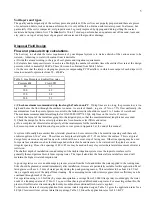
8
c) Condition soil moisture the day before opening trenches or installing WASTEFLOW™. Remember it is much easier to
install the system in moist soil. The soil should be moist but still should allow the proper operation of the installation
equipment. The best preparation is to saturate the soil one day before the installation of the WASTEFLOW™, so the soil
has time to drain. The soil surface should be dry so that the pipe puller or tractor maintains traction.
d) Install the system head first: Pumps, main valves, solenoid valves, filters, pressure regulator, chemical injector, pressure
sensors and water meter. Then install the main lines. These should be buried at a depth of 30 to 45 cm, well below the
depth of the WASTEFLOW™ lines (10 to 30 cm). If there is a risk of freezing bury mainlines below the frost line. At all
times avoid getting debris into the system. Flush main lines, test for leaks and leave them full of water. Larger diameter
pipes left full of air in a trench that has not been compacted may "float".
e) Open trenches for the submain manifold and flush line manifold. These trenches should be 20 to 25 cm deep.
f) Clean submain and flushline manifold trenches, moisten and compact the bottom of the trench
.
(If this is not done, the
manifolds may "settle down" and slowly pull out the couplings and fittings). Assemble the submain manifold outside the
trench if practical. Connect to main PVC/Poly lines and to the system head. Flush these lines. A high water velocity is
required to carry away debris which may have entered the pipes before or during installation. Place the submain and flush
manifolds into the trench.
g) Installation method.
The size of the installation, type of soil, slope and cost and availability of labor will determine the best installation method.
If the installation is large enough a tractor mounted drip burying system is the most suitable. (Ditchwitch vibratory plough)
For smaller installations drip lines are easily installed by hand or with any of the pipe treching/burying machines described
in Table 4. A tubing injector tool which can be attached to the 2
1/4
" tool bar of most tractors is available from GEOFLOW.
A diagram of this is available on request.
- Cover all open ends including dripline ends to avoid getting debris into the system.
- Leave enough length at the beginning and end for connections. It is convenient to finish the last foot of the trench by
hand. This gives more room for connections. Beware of bending the drip tubing too tight during installation.
- Do not bend tubing below a 0.6 m radius because the pipe may kink, reducing the flow. Use elbows and fittings whenever
required or make the trenches with a wide radius bend.
- The pipe puller type machine should not be used in clay soils, as it forms an underground "pipe" and the water applied by
the system tends to run in the downhill direction. For clay soils use an alternative method as shown in Table 2.
- Fill the trench early in the morning when temperatures are low.
The dripline will elongate at high temperatures. If you
fill the trench in warm weather, the dripline will contract and severe stresses and "stretch" , and pulled fittings will result.
h) Connect drip lines to submain and flush manifolds. Flush again.
i) Run the system before covering. Check connections for leaks.
Drip line storage.
WARNING: ROOTGUARD is temperature sensitive. The protected life of your system will be reduced if you leave the
drip line outside exposed to the sun for a long period of time. Store the drip line in a cool shaded place until installed.
This
should be a consideration when installing the system in very warm and sunny areas. Your system life span will be
increased if it is buried an extra two or three inches below the soil surface, to avoid the warm temperature extremes.
5. OPERATING.
Amount of water to be applied.
The amount of water applied should not exceed that lost or used by the plants and drained out of the soil:
• Water applied too quickly, in excess of the absorption capacity of the soil will surface and may puddle.
• Water applied in excess of the retention capacity of the soil will be drained and will percolate down. • The water that is
retained by the soil will be either transpired by the plant or will be evaporated from the soil surface. This is called
evapotranspiration.






























